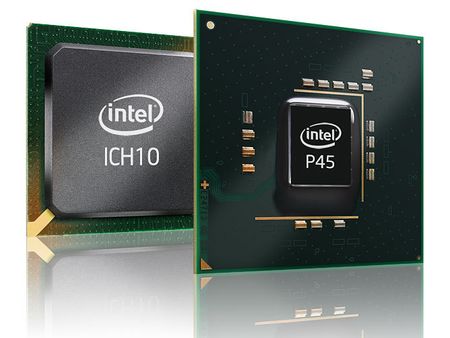Intel P45: The New Chipset Lacks Progress
P45 Express Chipset Details
We already mentioned some of the new features of the P45 chipset. It supports PCI Express 2.0 graphics, effectively doubling the bandwidth for each PCI Express link from 250 MB/s upstream and downstream to 500 MB/s each way. However, PCI Express 2.0 requires a PCI Express 2.0 slot and a PCIe 2.0-compliant expansion card (such as a graphics card) to take advantage of the increased bandwidth. We found that PCI Express 2.0 is not really necessary under mainstream conditions. The controller may reduce the link speed to PCI Express 1.0 speed, though, and it is possible to reduce the number of used PCI Express lanes to minimize power consumption. Since PCI Express 2.0 is fully backward compatible, it is the best choice if you intend to purchase a new platform today.
P45 Requires More Power Than P35
PCI Express 2.0 does requires more power, making the P45 less energy-efficient than its predecessor, despite the fact that P45 is manufactured using Intel’s 65 nm process. As you can see in our benchmark section, the difference in power requirements is not dramatic, but it is there.
We believe that this should not be the case. A new product has to be as least as good as its predecessor, which isn’t the case in the power consumption discipline. That’s particularly noteworthy, as Intel even promotes power savings when it talks about the improved performance per watt of DDR3 when compared to DDR2. This may certainly be the case, but DDR3 is only faster than DDR2 when operated at much faster speeds. This has not translated to performance gains that justify going for DDR3, and DDR3 will not have its breakthrough until high memory densities (4 Gb ICs) reach the mainstream.
XMP, Extreme Memory Profile
Another improvement is Intel’s XMP, which stands for Extreme Memory Profile. This is a feature you definitely want to have, as it allows the motherboard to configure the memory speed and timings to the fastest possible values instead of utilizing the conventional SPD information (which has provided auto-configuration for many years, but which is limited to safe, slow settings). XMP has been available on the X38 and X48 chipsets for several months, and is now hitting the mainstream with the P45. While it is a neat feature for beginners and some advanced users, it isn’t the most ideal solution for fine-tuning memory performance, as the memory vendors still have to make sure that their programmed XMP settings will work in all common systems.
The P45 is the first mainstream Intel chipset to support 16GB of memory, while the P35 is limited to 8GB. We found this interesting to mention, although we doubt that anything above 8GB will be necessary within the next 2-3 years.
Get Tom's Hardware's best news and in-depth reviews, straight to your inbox.
Current page: P45 Express Chipset Details
Prev Page Eaglelake Has Landed Next Page ICH10 Southbridge